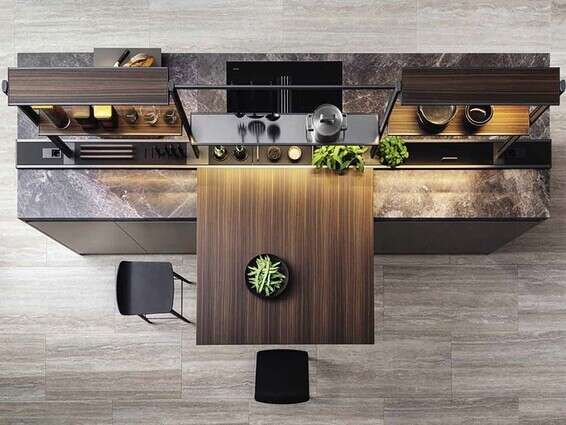How is the kitchen adapted to the days when, in addition to cooking and eating, it is also used for studies and work?
Tollman's Dada Kitchens.
Pantry and smart storage solutions
Photography:
Courtesy of Tollman's
Produced by the Department of Special Supplements
The corona crisis may revolutionize kitchen design, an area that even on weekdays explodes with creativity.
Designers around the world are trying to digest the dramatic changes in their daily routines, translating them into solutions that will become part of our new day-to-day life.
"The global health crisis, along with the global trend to adopt a healthy lifestyle, has turned the kitchen into an ecosystem that works to improve our health and well-being."
These words were written by experts who studied trends in the field of cuisine in the 21st century as part of an in-depth study by the Siliston Research Institute of the House of Cosentino.
23 experts and opinion leaders in the fields of anthropology, sociology, nutrition, technology, architecture and sustainability, and more than 800 trend forecasters and key figures in the kitchen industry around the world, took part in a study that comprehensively summarizes prominent trends in the kitchen crisis.
The main points of the report revealed that the reality we are experiencing now forces us more than ever to maintain our health. We must be aware of our mind and body and adopt healthy habits when buying, storing and cooking food. All of these have implications for kitchen design and adjustments we need to make.
Even before the current health crisis, experts brought up significant lifestyle changes: 49% have changed eating habits in recent years, 41% have consumed less processed food, 31% cook properly and try not to eat processed foods, 22% worry about food source.
According to the study, the interest in adopting a healthy lifestyle has changed traditional eating patterns, whether for reasons of nutrition or due to the growing concern for quality and source of food.
This perception has led to changes in the purchase, storage and preparation of food, along with the introduction of new ways of planning and organizing kitchens.
The kitchen in the center
The current Corona crisis and with it the closure imposed on us shed a special spotlight on the family's much preoccupation with the kitchen.
The kitchen has become the heart of the home, sometimes a workplace for parents, a place to prepare children's zoom lessons and also a therapy place for the mother to show creativity in baking challah in the shape of keys, so that she too can upload something on social media.
If that's not enough, then the new guidelines do not go out to restaurants and cook more fresh home meals immediately.
The new lifestyle, the architects and interior designers testify, changes the architectural program of the house and puts the issue of functionality and modularity at the top of the list when it comes to kitchen design.
The functionality is designed to safely and optimally match cooking tasks - heat points, smoke extractors, power points, application of new technologies that ensure, for example, hygiene, heat resistance or long-term durability with other activities transferred from other rooms, such as watching TV or entertaining family and friends.
"Modular kitchens, which are able to adapt to the changing needs of the home, are the answer to the new reality in which we live," says Liron Schwartz-Gilat, director of the DADA kitchens brand at Tollman's.
A prominent example is the Sistema XY kitchen designed by Francesco Medac, which includes a modular mechanism that allows the kitchen to be adapted to the changing needs of the house's occupants.
Environmental awareness also has an impact on kitchen planning, from the buying habits to the lifestyles of the house’s occupants.
Variables such as whether the family separates waste, whether it makes an effort to reduce water and energy use, whether it purchases fresh products or in cans have considerable significance.
Environmental awareness in kitchen design is also related to the materials from which the kitchen is designed - wood, concrete, Dekton surfaces and Siliston surfaces from the Loft collection that are known to be sustainable and in their production they promote a green environmental agenda.
Virtual spaces, including Instagram, Facebook, WhatsApp, Twitter, blogs, chats, forums, e-mail and websites, are becoming the perfect excuse to spend more time in the kitchen and tailor it to be much more photogenic and functional.
Survey results
1. The kitchen is the multipurpose space.
43% of users eat the main meals in the kitchen.
29% meet with guests, 11% work and 17% perform a variety of tasks in this space.
2. The kitchen has ceased to be a completely feminine space.
64% of women cook regularly, compared to 29.9% of men and 6.7% in the case of other family members or outsiders, such as domestic workers.
The kitchen is perceived as a space for health care and well-being.
48.9% have changed their eating habits in recent years.
62% care more about nutrition, 31.1% cook properly using less comfortable food.
In relation to our situation, 40.74% say they eat less processed food, a figure that is above average in other countries.
4. Kitchen use is affected by environmental awareness.
35% separate the waste they produce;
21.6% use less plastic;
16% of recyclers;
26.9% reduce water and energy use;
52.2% use reusable bags;
20.3% diversified the place of purchase to ensure quality;
14.5% attach more importance to bulk purchases and 13% order online.
Talking real estate with Ofer Petersburg. Listen to the new podcast >>
5. The kitchen is dominated by social media.
54% use social media as inspiration to renovate or renovate their kitchen;
51.8% use media for information on recipes, new diets, food and restaurants;
13.8% turn to the network for information on recycling, reuse or waste reduction;
62% take better care of their diet because they have social media as a source of information;
54.7% use their mobile phone to interact with devices (home appliances, lights, TV).
6. Functionality is superior to aesthetics.
63% of the respondents in the survey are looking for functionality, while 15% are driven by savings, 12% by the quality of the materials and 10% by design and aesthetics.
The Siliston Institute is an international platform driven by the Cosentino Group with the aim of researching and disseminating knowledge about the home and Mac kitchen space.
Produced by the Department of Special Supplements














